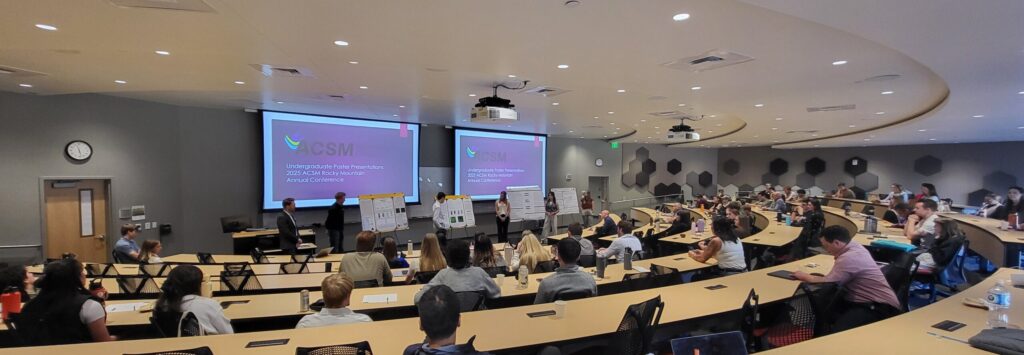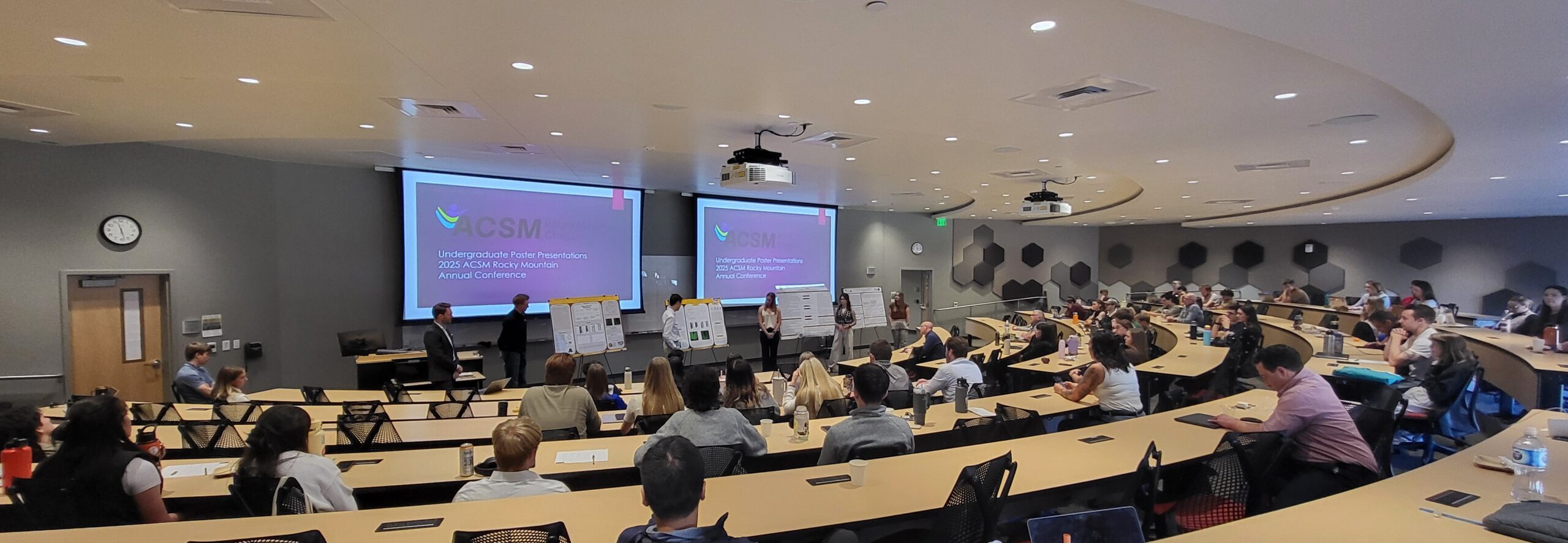

Annual Meeting

Rocky Mountain ACSM 2025 Annual Meeting
April 11 - 12, 2025
Hybl Sports Medicine and Performance Center
University of Colorado, Colorado Springs
Thank you for a wonderful 2025 meeting!
We look forward to seeing you in 2026 – location announcement to come!
Congratulations to our Student Winners

Student Bowl Champions:
From Western Colorado University:
The Snow Brains
President’s Cup Winner:
Joshua Kniss, University of Colorado, Anschutz
Undergraduate Poster Blitz:
Ava Schroeder, University of Colorado
Undergraduate Poster Honors:
Jarom Davidson, University of Wyoming
Jessica Franson, Colorado State University
Sherry Negaard, University of Wyoming
Master’s Poster Honors:
Darby Easterday, Colorado State University
Christina Cheng, Colorado State University
Oscar Chavez, University of New Mexico
Jacob Dawson, Colorado State University
Michael Torres, University of Wyoming
Doctoral Poster Honors:
Edwin Rodriguez, University of Northern Colorado
Emma Gomes, Colorado State University
Andrew Harding, University of Colorado
We would like to thank our professional speakers, Dr. Jim Doorley from the USOPC and Dr.Yasuki Sekiguchi from Texas Tech.
We would also like to thank ALL our students for a wonderful conference! Without you this would not have been possible.
Future Conference Information
Abstract Information

Abstract Deadline has passed for 2025. Please return in early 2026 for the latest information.
Preparing your abstract
Abstracts are limited to 2,000 characters (not including spaces, title, or author block). If including a table, chart, or graph, character limit will be approximately 1,500 characters depending on the size of the graphic.
Do not use brand names in the abstracts.
Abstracts must be written in English. Use standard abbreviations, symbols, and punctuation. When using abbreviations in the body of the abstract, spell out in first mention, followed by the abbreviation in parentheses.
Formatting: All abstracts should be in Times New Roman, 10- point font, with 0.5” margins and single line spacing. If there are major issues with formatting, and you agree to have your abstract published, you may receive your abstract back to meet these guidelines.
Title: The title should be brief (limited to 15 words) and typed in ALL CAPS, BOLD and ITALICIZED.
Authors: The first initial(s) and last names of the authors should be used with the presenting author first. The first author should be bolded. Do not include degrees or titles. Fellows of ACSM should use FACSM after their name. Use numerical values in superscript following the authors last name to identify author affiliations when there is more than one affiliation.
Institutions: The affiliation/institution of the authors should be included. Do not include departments.
Text: The abstract must be informative, including a statement of the study’s specific PURPOSE, METHODS, summary of RESULTS, and CONCLUSION statement using these headings. It is unsatisfactory to state, “The results will be discussed.” Abstracts should include relevant data, including but not limited to, mean data, standard deviation/standard error, and p-values. It is not satisfactory to only include statistical results (such as, “groups were different at p<.05).”
Financial Support: If your research was funded by financial support (e.g. a grant), please place one line of text below the abstract sharing the funding source.
Regulatory Compliance
Human studies must comply with the ACSM statement regarding the use of human subjects and informed consent (MSSE, Vol. 30, No. 7, July 1998, “Policy Statement Regarding the Use of Human Subjects and Informed Consent”). Animal studies must comply with NIH guidelines regarding the use of animals. To ensure consistency and clarity authors must use the terms as defined by MSSE, “Information for Authors” and utilize the units of measurement of the Systeme International de’Unite (SI).
Rules for Submission
- Please try to limit student and professional submissions to one first author abstract per individual. Individuals may co-author as many other abstracts as desired.
- The primary author must submit the abstract to the account associated with the Rocky Mountain regional chapter: rockymountainacsm@gmail.com. In your email ‘Subject’ line, please include the following: 2025 RMACSM Annual Meeting Abstract – XX (first author initials)
- All abstracts should be submitted prior to Friday, March 21 by 5 PM Mountain Time. There will be no extension and abstracts submitted after this time will not be accepted for review.
- The student level category should be based on student status when the research was completed.
- By submitting the abstract, the first author is verifying they substantially initiated and performed the research.
- All files should be submitted as “FirstAuthorLastName_AbstractCategory_ACSMRM2025”.
- All authors must approve the abstract prior to submission.
- Students and their mentors have the option to publish the abstract in a special issue of the International Journal of Exercise Science.
- Masters and Doctoral level abstracts will have the option to be considered for the President’s Cup Award. President’s Cup competitors will need to prepare a poster for the competition
- A $10 non-refundable abstract submission fee shall be paid using the following link: https://paypal.me/RMACSM?country.x=US&locale.x=en_US
- Submissions that do not follow these guidelines may be rejected or returned for revision. Revisions must be submitted prior to the deadline to be considered.
Notification of Acceptance and Programming
Abstracts will be formally reviewed by the abstract committee. The final acceptance decision is the exclusive right of the Abstracts Coordinator and the Abstract Committee.
The primary author will be notified electronically, which will include the type of presentation (poster or oral) as determined by the Abstracts Committee.
Accepted abstracts will be published on the website, as well as a special issue of the International Journal of Exercise Science, unless indicated otherwise.
ABSTRACT EXAMPLE
THE EFFECTS OF PARKINSONIAN POSTURE AND OBSTACLE CLEARANCE ON GAIT INITIATION IN YOUNG ADULTS
Author, A., Author, B., Author, C.
The University, Somewhere, Colorado
Parkinson’s disease is a neurodegenerative disorder kinematically characterized by a hunched posture and freezing at gait initiation. Visual cues and obstacles are used therapeutically to assist patients during gait initiation. PURPOSE: To determine the effects of Parkinsonian posture and obstacle clearance on center of pressure (CoP) and ground reaction force (GRF) variables during quiet standing and gait initiation in young adults. METHODS: Five male and five female college students quietly stood on a force plate for five seconds, initiated gait with their right foot upon hearing an audible prompt, and then walked for three meters. Participants completed this procedure for three trials in the following four conditions: no obstacle (NU) and over a two-inch-high obstacle (OU) in their normal posture and no obstacle (NP) and walking over the two-inch-high obstacle (OP) in a Parkinsonian posture with 25 degrees of trunk flexion. Means of several computed CoP and GRF variables were evaluated between the two postures for quiet standing (t-test) and across the four conditions for gait initiation (ANOVA) (α = .05). RESULTS: During quiet standing, there were no significant differences between the normal and Parkinsonian postures in CoP distance, displacement, velocity, jerk, and maximum or minimum values; however, the minimum (backwards) anteroposterior position was different (NP=-0.015 ± 0.02, NU=-0.010 ± 0.007, p=.021). During gait initiation, there were significant differences in mediolateral impulse between NU and NP (NU=-83.2 ± 13.4, NP=-63.2 ± 12.4, p=.006), and between NP and OU (NP=-63.2 ± 12.4, OU=-79.8 ± 13.6, p=.033). There were also significant differences (p<.05) in maximum mediolateral force (NP>OU), minimum mediolateral force (NP>NU, NP>OP, and NP>OU), and maximum vertical force (NU>NP), though there were no significant differences (p>.05) of any variables between NU and OP. CONCLUSION: Stepping over an obstacle while assuming a Parkinsonian posture resulted in mediolateral mechanical variables during gait initiation that were more like those of normal walking compared to walking without an obstacle in that same posture. This finding may help explain why patients with Parkinson’s disease who experience freezing of gait are able to initiate gait more easily when stepping over an obstacle.
Poster Instructions
Past Meeting Abstracts
Student Quiz Bowl!
Compete against teams across the region to claim the title of RMACSM Student Bowl Champions! The winning team will receive complementary registration to ACSM’s Annual Meeting in Atlanta and compete against other teams from across the nation!
Rules:
- Each team must consist of three (3) undergraduate students who are currently enrolled (Spring 2025) and are members of RMACSM.
- Maximum of two (2) teams per University
- Each team must have a Professor sponsor.
2026 Schedule
Check back in early 2026
Thank you to RMACSM meeting sponsors!


